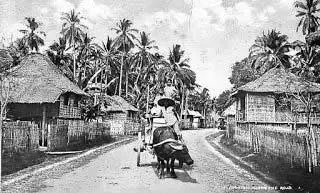When President Manuel L. Quezon Praised Batangas for Its Self-Sufficiency
Erstwhile “confidential records1” of Philippine Commonwealth President Manual L. Quezon’s conferences with the press in 1936 showed how high the level of esteem was with which he held the people of Batangas. This was just a year after the commonwealth came into existence.
Just to ensure that all readers are on the same page, the Philippine Commonwealth was “the administrative body that governed the Philippines from 1935 to 1946.” It was created by the Tydings-McDuffie or Philippine Independence Act which provided for a ten-year transition from colonial rule to independence. The commonwealth government, as provided for by the legislation, took the place of the American colonial or insular government2.
In one particular conference with the press, Quezon was asked about the employment figures, with – presumably – one reporter suggesting a staggering 55% unemployment rate. Let us all digress momentarily from the main topic and take a closer look at unemployment rate, which is the percentage of a country’s labor force actively looking for employment but unable to find jobs3.
In the present day, the “normal” unemployment rate for a country like the United States is about 5%4. The United States is, of course, a country of the First World. In recent years, unemployment rates in the Philippines had not been far behind: 5.7% in April 2017 and 5.5% a year later5.
 |
| A typical American era street scene in the Philippines. Image source: Scrapbook of Clyde Tavenner, online at the Internet Archive. |
In contrast, countries such as Kiribati (38.2%), the Marshall Islands (36%), Namibia (34%) and Venezuela (33.3%) all have remarkably high unemployment rates, albeit it has to be mentioned that “methods of calculation vary from country to country6.” Thus, the 55% suggested to Quezon was significant and probably devastating if seen by present day standards.
Quezon was quick to point out that the figure cited was probably unreliable:
“Some of the statistics that they sent him (the Labor Secretary) from the provinces gave as the number of unemployed figures greater than the inhabitants of the province. I think the only reliable data is in Manila…. It is very hard except through a census to determine what is the number of unemployed in the Philippines because we have seasonal laborers here.”
“The man who works in his rice farm works three months a year or five at most. Now, after the harvest, that fellow in unemployed because he refuses to work. He thinks he has done his work for the year and a very vigilant governor will count him among the unemployed. It is the same thing with the copra. In some provinces, they harvest the copra three times, in others four. The harvesting of the coconut lasts only a few days. For two months and a half, the copra laborers do nothing.”
Given the labor situation, Quezon then went on to say that he was considering proposing a bill requiring land owners to provide tenants with lots not just for their housing but also for them to raise hogs and chickens as well as plant vegetables. He said, “We have to educate our working men in the field to use for raising chickens, hogs and planting vegetables the rest of the time that they do not occupy in farming.”
If this could be done, he reasoned, “…there will never be a danger of hunger in the Philippines when the rice crop fails. These people will always have something to do; and we do not have to worry about unemployment.” Quezon then went on to praise the Province of Batangas for its self-sufficiency and the self-initiative of its inhabitants:
“They are doing it in Batangas, the one province in the Philippines that is demonstrating how self-supporting the Philippines can be. In Batangas, if the price of rice goes down, it makes no difference; the man from Batangas is not lacking food or [beset by] unemployment; he is working, and when the time comes he has a house; he has chickens and he has pigs; his wife is weaving or doing something. We really do not need any market. If we imitate what Batangas is doing, nobody can defeat the Philippines. Those fellows (likely in reference to Batangueños) are never complaining.”
2 “Commonwealth of the Philippines,” Wikipedia.
3 “Unemployment,” Wikipedia.
4 “What Is the New Normal Unemployment Rate?,” by Justin Weidner and John C. Williams, published 2011, online at the Federal Reserve Bank of San Francisco.
5 “Employment Rate in April 2018 is Estimated at 94.5 Percent,” online at the Philippine Statistics Authority.
6 “List of countries by unemployment rate,” Wikipedia.
